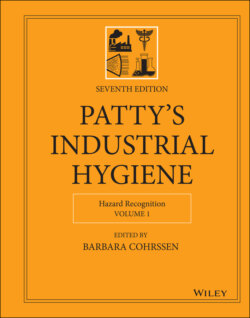Читать книгу Patty's Industrial Hygiene, Hazard Recognition - Группа авторов - Страница 114
3.2 Multidisciplinary Bow‐Tie Model
ОглавлениеAlthough the bow‐tie model is derived primarily from the safety profession and is designed for use by OS disciplines, it is also an excellent tool for use within and between EHS professionals.
Prevention can be seen in Figure 2 on the left side, serving as the barriers that seek to be appropriately placed to avoid a given hazard from becoming an unwanted central event. Although these barriers may differ across the EHS professions to achieve this prevention, they may also work in concert with one another or create new risks that require the consideration of additional barriers. Using a task with a high hazard chemical as an example, an IH may require the use of a glove box as a control barrier to eliminate potential exposures. An EA would now need to consider the hood's ventilation exhausting the chemical into the air and may require additional barriers to comply with local, regional, or national regulations. An OS may act more locally in considering whether the chemical's vapors may create flammability or electrical concerns inside the hood and may have barrier requirements to prevent these potential central events. Whether acting within these EHS disciplines, or acting as a singular EHS Generalist, all of these decisions will be based on potential risk. This figure clearly illustrates how communication of this risk is just as important for convincing management that investment in these barriers and their maintenance over time is necessary as it is for training workers that the proper use of these control barriers is essential.
Figure 2 Bow‐tie presented in a multidisciplinary format.
Looking at each of the EHS professions separately, this left‐side preference in (Figure 2 can also be seen in ergonomics, where the multiple strategies for controlling musculoskeletal risk factors can be seen as left‐side barriers 14, 15). However, an IH does not see work‐related risk prevention in the same manner. Chemical exposures are seen as the central event, and in most instances, their emission, the right side, is expected and full enclosure, elimination, and substitution are the only left‐side components. EAs are quite like IHs in this respect as both professions accept some level of exposure, whether to workers or the environment, as long as they are kept below regulatory limits or OELs by utilizing the barriers on both the left and right side of the central event. OPs also are more applied on the right side of the bow‐tie, perhaps even more so as they most often see patients that are experiencing signs of pending injury or illness or have already acquired adverse consequences. In fact, the OP and the services they offer can be seen as an effective right‐side barrier themselves, with medical surveillance blood draws, hearing tests, and respirator use examinations as examples. Although they are certainly key players for identifying the need for EHS expertise to assess and intervene in workplaces with identified issues, the OP's primary left‐side barrier utility is for their influence on job selection and allocation as examples of preventative actions. Therefore, when the bow‐tie is viewed as a multidisciplinary model for simplified risk communication, for the role of barriers to workers and management alike, it can be seen as a progressive process in which EHS disciplines unite to seek prevention and mitigation of unwanted work‐related injury, illness, or disease consequences (11).
